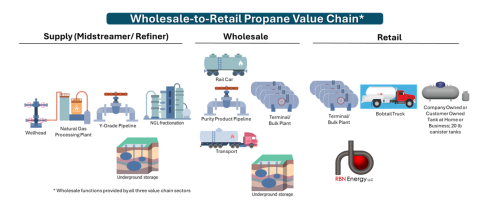More than 9 billion gallons of propane were delivered to U.S. consumer markets in 2024, primarily for residential heating and cooking. The final step in propane’s pathway to the retail market is managed by a large group of companies known as retailers, which range in size from “mom and pop” operations that run only a couple of cars serving a local market to companies with fleets of cars and multiple supply points. As we detail in today’s RBN blog, the propane business requires a huge focus on logistics and personal relationships.
This is the third blog in our series about propane markets. In Part 1, we outlined the journey of propane from wellhead to burner tip and discussed the various segments of the domestic propane market, including industrial, petrochemical, commercial, residential and agricultural demand. We also introduced the role of wholesalers (middle column in Figure 1 below) and retailers (right column). In Part 2, we detailed the role of wholesalers, whose primary function is to aggregate supplies, operate logistics networks, trade propane and integrate midstream operations. Recently, in Should I Stay Or Should I Go?, we reviewed some issues facing wholesalers today. In today’s blog, we will review retailers’ role and purpose in the market.
Figure 1. Wholesale-to-Retail Propane Value Chain. Source: RBN
To get to the retailer, propane travels from the wholesaler (see RBN’s Propane Infrastructure Map for details about propane terminals, pipelines and rail) via transport trucks with a capacity of between 5,600 gallons and 20,950 gallons, with an average truck carrying 11,600 gallons. (For more on the propane molecule’s journey, check out The Long and Winding Road.) Propane is moved on these trucks to smaller bulk and retail store sites. From there it is picked up by bobtail trucks (see photo below) with a specialized design: a) a roughly 2,500-to-3,500-gallon tank (though both bigger and smaller-sized tanks are available), b) an onboard delivery system, and c) safety equipment, including but not limited to electrical grounding, pressure-relief valves and emergency gear. Bobtail trucks deliver propane into tanks at homes usually ranging from 100 gallons to 1,000 gallons, with larger tanks at some businesses. Some of the propane is delivered to sites where it is transferred into 20-gallon and other small tanks, such as those used for home grilling.
Join Backstage Pass to Read Full Article










